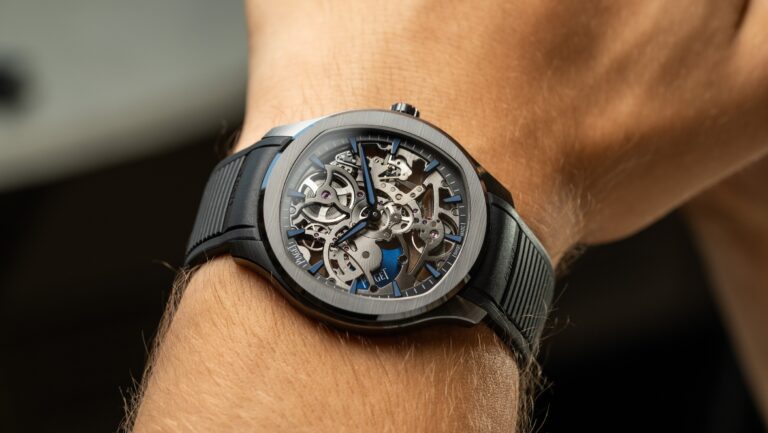Jamie Weiss
Luxury watchmakers have long embraced ceramic as a material for watch cases. While it may not be as stereotypically appealing as precious metals, the vibrant colors it produces (and the difficulty of producing it) give it a unique allure. Known for its ultra-thin, lightweight watches, it’s surprising that Piaget hasn’t tried a ceramic watch sooner. Perhaps it’s a reflection of the maison’s austerity. But the stealthy-looking black-and-blue Piaget Polo Skeleton Ceramic further modernizes the model with a sportier construction.
Of course, it’s no surprise that the Polo is Piaget’s first ceramic watch. Since its launch by Yves Piaget in 1979, the Polo has always been a canvas for Piaget to unveil new innovations, notable milestones include the Polo becoming Piaget’s first skeleton sports watch in 1982, the first Piaget to feature a rubber strap in 2009, and the first Piaget to feature a quick-change strap system in 2021. It’s also Piaget’s sportiest watch line, so it’s no surprise that it’s made of ceramic.

According to Piaget, the development of the Polo Skeleton Ceramic took three years and required a complete redesign of the Polo case. The two-part case and crown are made of jet-black brushed ceramic, sandwiching a black DLC titanium midcase that houses the movement. The movement also features black DLC elements, giving the whole watch a stealthy tone-on-tone look. What’s impressive is that the Piaget Polo Skeleton Ceramic is just 7.9mm thick, 1.4mm thicker than the existing Piaget Polo Skeleton steel and gold models. However, in return, the case is water-resistant to 50m instead of 30m. This is the result of an effort to make the Polo Skeleton even sportier and more suitable for everyday wear.

This is also why the new Piaget Polo Skeleton Ceramic comes with two rubber straps, one in black numbers and one in blue numbers (in keeping with the theme), which can be easily interchanged thanks to Polo’s Single-Touch Quick-Change system. By pivoting to two rubber straps rather than the bracelet-and-leather bundle seen on the previous steel models, or the sole leather strap offered on the precious metal models, the Polo Skeleton Ceramic takes on an even sportier dimension.

Like previous Polo Skeleton models, this one is powered by the in-house caliber 1200S1, an ultra-thin micro-rotor movement with a 44-hour power reserve. The movement’s design is very pleasing to the eye, with a gracefully curved armature, an exposed barrel at 12:30, and a blue micro-rotor visible on both sides of the watch. The indexes and hands are also filled with dark blue Super-LumiNova, accentuating the dark-time theme.

The Polo Skeleton Ceramic may be one of the sportiest pieces the brand has ever produced. At least, the tougher ceramic and titanium case and nearly double water resistance to 50 meters make it the sportiest Polo Skeleton. The first use of ceramic is an exciting milestone for the watchmaker and jeweler Piaget, and we hope to see it featured in other Polo watches. Of course, just like when it was founded in 1979, Piaget has aimed to offer something sportier, but with uncompromising jet-setting and luxury style and glamour. The US$42,900 price tag may not fit everyone’s budget or lifestyle, but it will undoubtedly be a big draw for those who share the tastes of the 9P Society and prefer something more exclusive and conversation-starting on their wrist.
Pricing and Availability for the Piaget Polo Skeleton Ceramic

The Piaget Polo Skeleton Ceramic is available now at Piaget retailers. Price: USD 42,900, AUD 69,500
Brand Piaget Model Polo Skeleton Ceramic Reference Number G0A49011 Case Size 42mm (D) x 7.9mm (T) Case Material Black ceramic and black DLC titanium Water Resistance 50 meters Crystal Sapphire on front and back Dial Skeletonized, black DLC titanium, dark blue Superluminova Strap Black rubber, steel, titanium folding clasp, Single Touch Quick Change system,
Additional blue rubber strap Movement Caliber 1200S1, in-house, micro-rotor automatic Power reserve 44 hours Functions Hours and minutes Availability Current price $42,900 USD
69,500 Australian dollars
